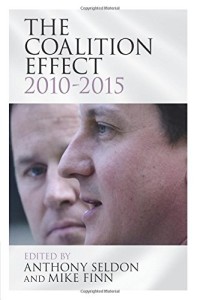The Coalition Effect, 2010-2015: an oddly incomplete study
The Coalition Effect comes with an impressive pedigree, both in terms of the authors and the contributors. It’s a detailed, lengthy work with chapters structured around policy areas, providing for each a basic summary of key events as well as a rather varying level of analysis.
 Depth is sacrificed for breadth at times and as a few authors take a very opinionated line it also means some mainstream interpretations of events get very little time of day in their chapters. More problematic, however, is that the book is less than the sum of its parts due to the decision to neglect three major areas of coalition.
Depth is sacrificed for breadth at times and as a few authors take a very opinionated line it also means some mainstream interpretations of events get very little time of day in their chapters. More problematic, however, is that the book is less than the sum of its parts due to the decision to neglect three major areas of coalition.
First, the very fact that was a coalition. Why did Cameron offer one? Why did the Liberal Democrats abandon their previous opposition to one? Both questions get only very cursory treatment despite being central to the political shape of the 2010-15 Parliament.
Second, what difference did coalition as opposed to confidence and supply make? The question of economic stability is – as is standard – pretty much the only answer offered to that question, which is disappointing in a book so long and detailed. There’s no discussion, for example, of the power (or not) that ministers have to make decisions outside of votes in Parliament. Did coalition give the Tories less power and the Lib Dems more because it means Lib Dem ministers making decisions day by day in government. Or were those sorts of decisions minor compared to what gets voted on in Parliament? How do the policy changes analysed in the book stack up when viewed through the prism of did/didn’t require votes in Parliament to be won?
Third, and turning specifically to the Liberal Democrats, their impact on coalition gets often mentioned but in bizarrely haphazard ways. It’s decidedly rum that I am mentioned more often in the book than same-sex marriage – and the latter only gets mentioned in the context of Tory grassroots unhappiness with Cameron’s leadership. Mental health gets more of a mention, but even it only has a three-paragraph section in an otherwise excellent chapter on health services – a neglect of the topic which sits rather oddly with the idea of a book about “the coalition effect” given how much political capital the Liberal Democrats put into mental health in the second half of the Parliament. If you’re looking at coalition effects, here is a prime subject for discussion.
Indeed, if you are hoping the book will take you through an assessment of the impact the Liberal Democrats claimed to make in coalition you’ll be disappointed because this patchy coverage means several of the major claims the Lib Dems make either do not get mentioned or get mentioned but without consideration of whether it was the Lib Dems making them happen.
As with Matthew D’Ancona’s In It Together, this then is a study of the government and the Conservatives with passing and inconsistent references to some of the Liberal Democrats. It’s not a study of the coalition or of how coalitions more generally operate for there are far too many gaps left in the coverage to do either of those tasks.
As a result, this a good, solid book to read as one of a handful on the topic rather than the definitive study and starting point for research and investigation.
If you like this, you might also be interested in The Politics of Coalition: How the Conservative-Liberal Democrat Government Works by Robert Hazell and Ben Yong.
Got a view on this review? Then please rate it on Amazon.
Buy The Coalition Effect, 2010-2015, edited by Anthony Seldon and Mike Finn here.
Note: a copy of this book was provided to me by the publisher.
Leave a Reply